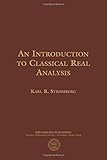An introduction to classical real analysis
Material type: TextPublication details: Rhode Island, American Mathemaical Society: [c1981]Description: 577 pISBN: 978-1-4704-2544-9Subject(s): MathematicsLOC classification: QA300
TextPublication details: Rhode Island, American Mathemaical Society: [c1981]Description: 577 pISBN: 978-1-4704-2544-9Subject(s): MathematicsLOC classification: QA300| Item type | Current library | Collection | Shelving location | Call number | Status | Notes | Date due | Barcode | Item holds |
|---|---|---|---|---|---|---|---|---|---|
 Book
Book
|
ICTS | Mathematic | Rack No 6 | QA300 (Browse shelf (Opens below)) | Available | Billno:IN 003 582; Billdate: 2018-01-11 | 00877 |
Browsing ICTS shelves, Shelving location: Rack No 6 Close shelf browser (Hides shelf browser)
Chapter 0. Preliminaries
Chapter 1. Numbers
Chapter 2. Sequences and series
Chapter 3. Limits and continuity
Chapter 4. Differentiation
Chapter 5. The elementary transcendental functions
Chapter 6. Integration
Chapter 7. Infinite series and infinite products
Chapter 8. Trigonometric series
This classic book is a text for a standard introductory course in real analysis, covering sequences and series, limits and continuity, differentiation, elementary transcendental functions, integration, infinite series and products, and trigonometric series. The author has scrupulously avoided any presumption at all that the reader has any knowledge of mathematical concepts until they are formally presented in the book.he exercise sets are a particularly attractive feature of this book. A great many of the exercises are projects of many parts which, when completed in the order given, lead the student by easy stages to important and interesting results. Many of the exercises are supplied with copious hints. Thanks to the generous help of the author's friend, Professor Robert Burckel, this new printing contains a large number of corrections, a short author biography as well as a list of selected publications of the author.Stromberg's book gives an excellent treatment of real analysis. Making no assumption that the reader is familiar with "baby real variables," it starts from the beginning and develops the Lebesgue theory of measure and integration, then applies the techniques to a study of Fourier analysis. The book is a classic, suitable as a text for the standard graduate course. It's great to have it available again!.---Summary provided by publisher








There are no comments on this title.